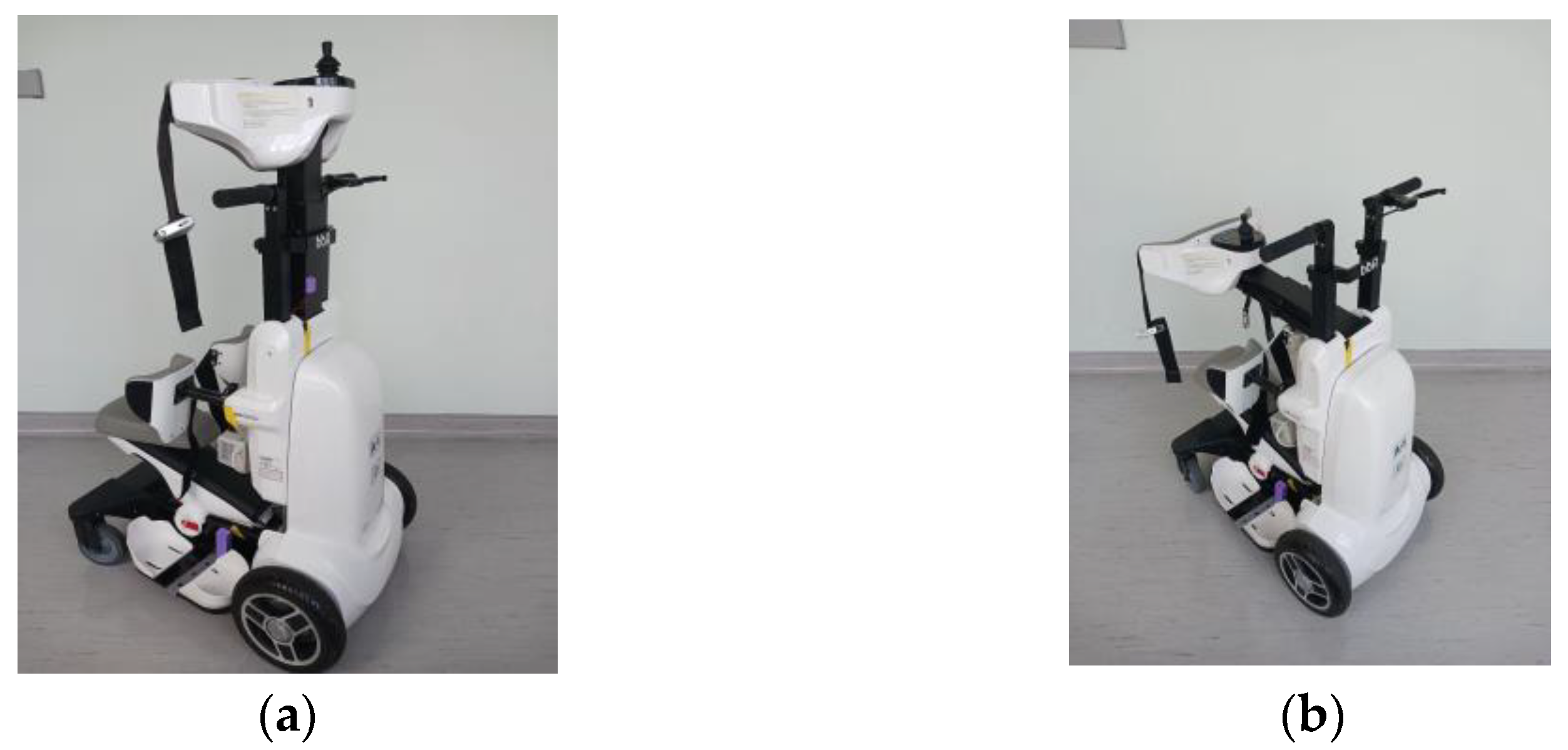Development of an Embedded Device for Quantifying and Recording Daily Standing Profiles in Individuals with Lower Limb Motor Impairment Using an Assistive Standing Mobile Device †
Abstract
:1. Introduction
1.1. Background
1.2. Related Work
2. Method and Material
2.1. Components
2.1.1. Microcontroller Unit
2.1.2. 4G Module
2.1.3. Inertia Measuring Unit (IMU)
2.1.4. Foot Switch Module
2.1.5. Power Module
2.2. Mechanism
2.3. Data Validation
3. Conclusions and Discussion
3.1. Compliance of Prescribed Intervention
3.2. Privacy
3.3. Accessibility
4. Limitation and Future Development
Author Contributions
Funding
Informed Consent Statement
Data Availability Statement
Acknowledgments
Conflicts of Interest
References
- Sarajchi, M.; Sirlantzis, K. Design and Control of a Single-Leg Exoskeleton with Gravity Compensation for Children with Unilateral Cerebral Palsy. Sensors 2023, 23, 6103. [Google Scholar] [CrossRef] [PubMed]
- Alekna, V.; Tamulaitiene, M.; Sinevicius, T.; Juocevicius, A. Effect of weight-bearing activities on bone mineral density in spinal cord injured patients during the period of the first two years. Spinal Cord 2008, 46, 727–732. [Google Scholar] [CrossRef] [PubMed]
- Alfano, C.M.; Cheville, A.L.; Mustian, K. Developing high-quality cancer rehabilitation programs: A timely need. Am. Soc. Clin. Oncol. Educ. Book 2016, 36, 241–249. [Google Scholar]
- Martelli, M.F.; Zasler, N.D.; Tiernan, P. Community based rehabilitation: Special issues. Neuro Rehabil. 2012, 31, 3–18. [Google Scholar] [CrossRef] [PubMed]
- Rodby-Bousquet, E.; Agustsson, A. Postural Asymmetries and Assistive Devices Used by Adults with Cerebral Palsy in Lying, Sitting, and Standing. Front. Neurol. 2021, 12, 758706. [Google Scholar] [CrossRef] [PubMed]
- Allen, L.; Richardson, M.; McIntyre, A.; Janzen, S.; Meyer, M.; Ure, D.; Willems, D.; Teasell, R. Community stroke rehabilitation teams: Providing home-based stroke rehabilitation in Ontario, Canada. Can. J. Neurol. Sci. 2014, 41, 697–703. [Google Scholar] [CrossRef] [PubMed]
- Rezaei, M.; Sharifi, A.; Vaccaro, A.; Rahimi-Movaghar, V. Home-Based Rehabilitation Programs: Promising Field to Maximize Function of Patients with Traumatic Spinal Cord Injury. Asian J. Neurosurg. 2019, 14, 634–640. [Google Scholar] [CrossRef] [PubMed]
- Martin, L.R.; Williams, S.L.; Haskard, K.B.; Dimatteo, M.R. The challenge of patient adherence. Ther. Clin. Risk Manag. 2005, 1, 189–199. [Google Scholar] [PubMed]
- Camara Gradim, L.C.; Archanjo Jose, M.; Marinho Cezar da Cruz, D.; de Deus Lopes, R. IoT Services and Applications in Rehabilitation: An Interdisciplinary and Meta-Analysis Review. IEEE Trans. Neural Syst. Rehabil. Eng. A Publ. IEEE Eng. Med. Biol. Soc. 2020, 28, 2043–2052. [Google Scholar] [CrossRef] [PubMed]
- Fan, Y.J.; Yin, Y.H.; Da Xu, L.; Zeng, Y.; Wu, F. IoT-based smart rehabilitation system. IEEE Trans. Ind. Inform. 2014, 10, 1568–1577. [Google Scholar]
- Škraba, A.; Koložvari, A.; Kofjač, D.; Stojanović, R. Prototype of speech controlled cloud based wheelchair platform for disabled persons. In Proceedings of the 2014 3rd Mediterranean Conference on Embedded Computing (MECO), Budva, Montenegro, 15–19 June 2014; IEEE: Piscateville, NJ, USA, 2014; pp. 162–165. [Google Scholar]
- Chiuchisan, I.U.L.I.A.N.A.; Geman, O.A.N.A. An approach of a decision support and home monitoring system for patients with neurological disorders using internet of things concepts. WSEAS Trans. Syst. 2014, 13, 460–469. [Google Scholar]



Disclaimer/Publisher’s Note: The statements, opinions and data contained in all publications are solely those of the individual author(s) and contributor(s) and not of MDPI and/or the editor(s). MDPI and/or the editor(s) disclaim responsibility for any injury to people or property resulting from any ideas, methods, instructions or products referred to in the content. |
© 2023 by the authors. Licensee MDPI, Basel, Switzerland. This article is an open access article distributed under the terms and conditions of the Creative Commons Attribution (CC BY) license (https://creativecommons.org/licenses/by/4.0/).
Share and Cite
Tsoi, K.-M.; Yu, K.-P.; Ng, C.-K.; Wong, S.-M.; Ng, R.; Yeung, T.-Y.; Chan, K.-L.; Ma, W.-L. Development of an Embedded Device for Quantifying and Recording Daily Standing Profiles in Individuals with Lower Limb Motor Impairment Using an Assistive Standing Mobile Device. Eng. Proc. 2023, 58, 91. https://doi.org/10.3390/ecsa-10-16011
Tsoi K-M, Yu K-P, Ng C-K, Wong S-M, Ng R, Yeung T-Y, Chan K-L, Ma W-L. Development of an Embedded Device for Quantifying and Recording Daily Standing Profiles in Individuals with Lower Limb Motor Impairment Using an Assistive Standing Mobile Device. Engineering Proceedings. 2023; 58(1):91. https://doi.org/10.3390/ecsa-10-16011
Chicago/Turabian StyleTsoi, Kim-Ming, King-Pong Yu, Chu-Kei Ng, Suk-Mun Wong, Riggs Ng, Tsz-Yan Yeung, Ka-Leung Chan, and Wai-Ling Ma. 2023. "Development of an Embedded Device for Quantifying and Recording Daily Standing Profiles in Individuals with Lower Limb Motor Impairment Using an Assistive Standing Mobile Device" Engineering Proceedings 58, no. 1: 91. https://doi.org/10.3390/ecsa-10-16011
APA StyleTsoi, K.-M., Yu, K.-P., Ng, C.-K., Wong, S.-M., Ng, R., Yeung, T.-Y., Chan, K.-L., & Ma, W.-L. (2023). Development of an Embedded Device for Quantifying and Recording Daily Standing Profiles in Individuals with Lower Limb Motor Impairment Using an Assistive Standing Mobile Device. Engineering Proceedings, 58(1), 91. https://doi.org/10.3390/ecsa-10-16011





